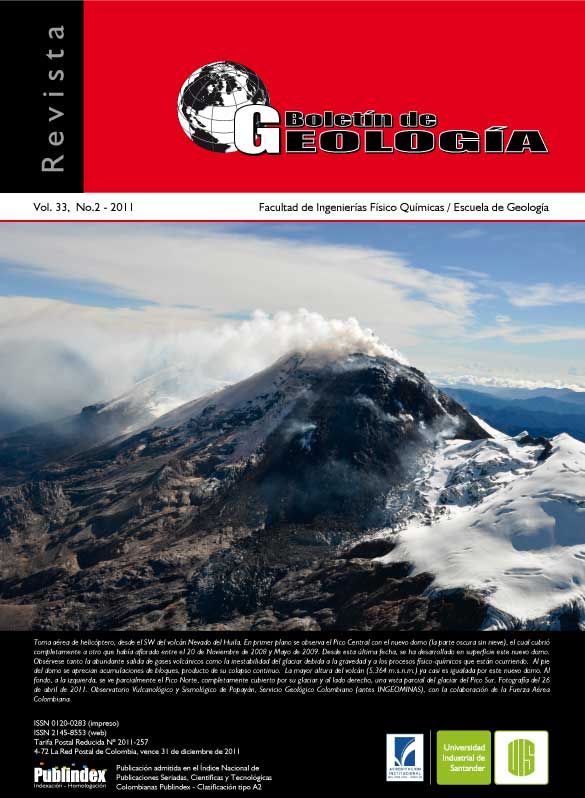FTIR, LIBS.PHYSICO CHEMICAL CHARACTERIZATION, TAPHONOMY AND ECOLOGYOF Orthokarstenia ewaldi (FORAMINIFERA: SIPHOGENERINOIDIDAE) LOSPINOS FORMATION (CRETACEOUS: MAASTRICHTIAN) FROM SAMACÁ(BOYACÁ, COLOMBIA)
Published 2011-12-06
How to Cite
Abstract
The Orthokarstenia genus is considered a microfossil guide to the ages of the Cretaceous period. Thecharacteristic species of Los Pinos Formation corresponding to Cretaceous Period and Maastrichtian age and fitsto the morphological description of Orthokarstenia ewaldi species. From the siliceous matrix several specimenswere taken and macerated for Fourier transform infrared spectroscopy (FTIR) testing with KBr base. Specimenswere collected from three levels of a rock. Three-dimensional images were taken with a video-microscopes to detail the form and structure of minerals. A fragment of rock was used to perform Laser-induced breakdown spectroscopy (LIBS) tests and to establish the presence of the elements Ca, Fe and Mg. Thin sections were also made and described. FTIR spectra of for aminifera were similar in the three levels where the samples were taken but showed differences with the spectrum of the silica matrix. LIBS analysis confirmed the presence of Ca and Fe in the samples. In thin sections, amorphous silica filling the shell was observed, and also a faint. trace of the original shell as a fine sediment. Traces of Ca found with LIBS analysis confirm the replacement of aragonite to magnesian calcite and finally to silica. Using the relationship between the variance and the mean of three sizes of squares was determined the dispersion of the specimens. The values obtained indicated a clustered distribution type. This type of distribution is indicative of the conditions of resources in the habitat, reproduction and dispersal mode. It is possible to infer that the dominant reproductive system of O. ewaldi was megalospheric, being the asexual forms more common.
Keywords: Benthic, Foraminifera, FTIR, LIBS, Upper Cretaceous.
Downloads
References
Camacho, H., y Longobucco, M. 2007. Los Invertebrados fósiles. Fundación de Historia Natural Feliz de Azara. Universidad Maimónides, 800p
Díaz, J., y Sotelo, C. 1995. Análisis estructural de la Falla de Boyacá en un área al oeste de los municipios de Paipa-Duitama. Tesis de grado. Universidad Nacional de Colombia. Bogotá.
Fabre, A. 1986. Geologie de la Sierra Nevada del Cocuy (Cordillère Orientale de Colombie). These présentèe à la Faculté des Sciences de l’université de Genève pour obtenir le grade de Docteur ès Sciences de la Terre, Genève
Hill, R.R., and Rendel, D.A.E. 1975. The Interpretation of Infrared Spectra. London: Heyden, 375p
Karsten, H. 1858. Uber die geognostichen verhaltnisse des westlichen Columbien, der heutigen Republiken Nev-Granada and Equator. Amtl.Ber.32. Versammlung Deutsches Naturfoscher
Koutsoukos, A.M. and Hart, M.B. 1990. Cretaceous Foraminiferal morphogroup distribution patterns, palaeocommunities and trophic structures: a case study from the Sergipe Basin, Brazil. Transactions of the Royal Society of Edinburgh: Earth Sciences, 81d: 221-246
Loeblich, A.R. Jr. and Tappan, H. 1988. Foraminiferal Genera and their Classification. Van Nostrand Reinhold Company (ed), 2: 1-970
Martínez, J.I. 1995. Microfósiles del Grupo Guadalupe y la Formación Guaduas (Campaniano–Maastrichtiano) en la sección de Tausa, Cundinamarca, Colombia. Ciencia, Tecnología y Futuro, 1(1): 65–82.
Miller, J.C. 1994. Laser Ablation, principles and applications. Springer-Verlag. New York
